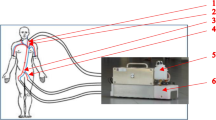Abstract
“Open-book” pelvic fractures associate a diastasis and/or a fracture of the pubic rami with a posterior pelvic disruption of the sacro-iliac joint. These uni or bilateral lesions are potentially lethal mainly due to associated injuries and massive pelvic hemorrhage. The most frequently injured arteries are parietal branch of the commune, internal or external arteries because of their proximity to the bone, the sacro-iliac joint and the inferior ligaments of the pelvis. The pelvic bone dislocation and the increase of pelvic volume facilitate blood effusion. The aim of this study was to determine, on a cadaver fracture model, the direct anatomical consequences of “open-book” pelvic fracture on the ilio-lumbar pedicle and the pelvic cavity volume. Materials and methods: Bilateral open-book pelvic ring injuries were created in ten non-embalmed cadaver specimens by directly disrupting the pubic symphysis, the right and the left sacro-iliac joints. Pelvic volume was determined after total pelvic exenteration. Consequences of this fracture on vascular parietal network, nervous pelvic trunk and pelvic cavity volume were studied. Results: The mean volume of the pelvic cavity after complete visceral exenteration was 872.5 cm3 (extremes 580–756 cm3). The average increase of pelvic volume was 20.8% after 5 cm of pubic diastasis. In all cases, because of a transversal disposition of the ilio-lumbar pedicle with regard to the sacro-iliac joint, reproduction of the open-book fracture caused a venous dilaceration of the ilio-lumbar vein in 12 cases after 5 cm of pubic diastasis (12/20=60%). No arterial dilaceration was observed on the ilio-lumbar artery, but this artery was put in tension. Conclusion: Open-book fractures create an increase of pelvic volume that facilitates blood diffusion from parietal pelvic vascular network. Ilio-lumbar pedicle seems to be very vulnerable in this type of fracture because of its relations to the sacro-iliac joint and its transversal disposition with regard to this joint.



Similar content being viewed by others
References
Ben-Menachem Y, Coldwell DM, Young JWR, Burgess AR (1991) Hemorrhage associated with pelvic fractures: causes, diagnosis and emergent management. AJR 157:1005–1014
Bottlang M, Simpson T, Sigg J, Krieg JC, Madey SM, Long WB (2002) Non invasive reduction of open-book pelvic fracture by circumferential compression. J Orthop Trauma 16:367–73
Chen RS, Liu YX, Liu CB, Hu YS, Xu DC, Zhong SZ, Li ZH (1999) Anatomic basis of iliac crest flap pedicled on the iliolumbar artery. Surg Radiol Anat 21:103–107
Cormier JM (1980) Complications vasculaires immédiates des fractures du bassin. In: Dejour H, Cormier JM (eds) Le traitement des fractures du bassin et de leurs complications immédiates. Monographies de l’association française de chirurgie. Masson, Paris, pp 65–91
Ghanayem AJ, Wilber JH, Lieberman JM, Motta AO (1995) The effect of laparotomy and external fixator stabilization on pelvic volume in an unstable pelvic injury. J Trauma 38:396–400
Grimm MR, Vrahas MS, Thomas KA (1998) Pressure-volume characteristics of the intact and disrupted pelvic retroperitoneum. J Trauma 44:454–459
Miller PR, Moore PS, Mansell E, Meredith JW, Chang MC (2003) External fixation or arteriogram in bleeding pelvic fracture: initial therapy guided by markers of arterial hemorrhage. J Trauma 54:437–443
Tile M (1986) Fractures of the pelvis and acetabulum. Urban and Schwartzenberg, Baltimore
Yiming A, Baqué P, Rahili A, Mayer J, Braccini AL, Fontaine A, Leplatois A, Clavé A, Bourgeon A, de Peretti F (2002) Anatomical study of the blood supply of the coxal bone: radiological and clinical application. Surg Radiol Anat 24:81–86
Author information
Authors and Affiliations
Corresponding author
Rights and permissions
About this article
Cite this article
Baqué, P., Trojani, C., Delotte, J. et al. Anatomical consequences of “open-book” pelvic ring disruption. A cadaver experimental study. Surg Radiol Anat 27, 487–490 (2005). https://doi.org/10.1007/s00276-005-0027-2
Received:
Accepted:
Published:
Issue Date:
DOI: https://doi.org/10.1007/s00276-005-0027-2




